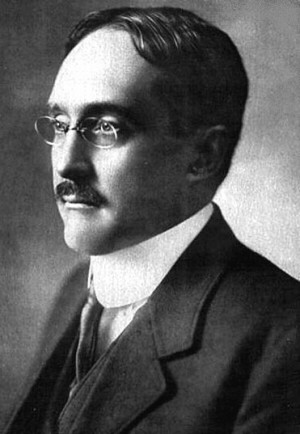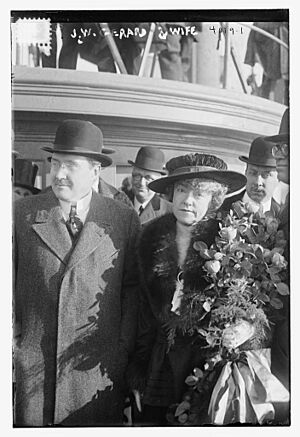James W. Gerard facts for kids
Quick facts for kids
James W. Gerard
|
|
|---|---|

Gerard in 1916
|
|
| Treasurer of the Democratic National Committee | |
| In office August 11, 1924 – June 1932 |
|
| Preceded by | Wilbur W. Marsh |
| Succeeded by | Frank C. Walker |
| 7th United States Ambassador to Germany | |
| In office October 29, 1913 – February 5, 1917 |
|
| President | Woodrow Wilson |
| Preceded by | John G. A. Leishman |
| Succeeded by | Ellis Loring Dresel (Acting, 1921) |
| Personal details | |
| Born |
James Watson Gerard III
August 25, 1867 Geneseo, New York |
| Died | September 6, 1951 (aged 84) Southampton, New York |
| Education | Columbia University (A.B., A.M.) New York Law School (LL.B.) |
| Military service | |
| Allegiance | |
| Branch/service | New York National Guard |
| Years of service | 1892–1904 |
| Rank | Major |
| Unit | 1st Brigade |
| Battles/wars | Spanish–American War |
James Watson Gerard III (born August 25, 1867, died September 6, 1951) was an important American lawyer and diplomat. He also served as a judge on the New York Supreme Court.
Contents
Early Life and Education
James Watson Gerard III was born in Geneseo, New York. His father and grandfather, both named James Watson Gerard, were also well-known lawyers in New York.
He went to Columbia University, where he earned two degrees. Later, he studied law at New York Law School. He finished his law studies in 1892.
A Life of Public Service
Gerard was involved in politics from a young age. He led the Democratic Party's campaign committee in New York County for four years.
He also served in the National Guard of the State of New York. During the Spanish–American War in 1898, he worked on General McCoskry Butt's team. From 1900 to 1904, he was a major in the Guard's 1st Brigade.
In 1907, he was elected as a judge to the New York Supreme Court. He served as a judge until 1911.
U.S. Ambassador to Germany
From 1913 to 1917, James Gerard served as the American Ambassador to Germany. He was chosen for this important role by President Woodrow Wilson.
In 1914, Gerard ran for U.S. Senator from New York. He won the Democratic primary election against Franklin D. Roosevelt. However, he lost the main election to James W. Wadsworth, Jr..
When World War I began in 1914, Gerard took on extra duties. He looked after the interests of British citizens in Germany. He also visited camps where British prisoners were held and helped improve their conditions. The American embassy in Berlin became a central point for handling German interests in other countries like France and Britain.
Gerard helped clear up questions about Germany's actions at the start of the war. He confirmed that Germany had to break Belgium's neutrality for military reasons. He even sent a private message from the German Kaiser to President Wilson about this.
After a ship called the RMS Lusitania was sunk in 1915, many Americans died. This made Gerard's job as ambassador much harder.
In January 1917, the German government asked him to leave. Diplomatic relations between the U.S. and Germany ended on February 3. Gerard was held for a short time because of false rumors. Once the rumors were proven wrong, he was allowed to leave Germany. He retired from his diplomatic role in July 1917.
Later Career and Writings
After his time as ambassador, Gerard returned to New York City to practice law. He wrote two books about his experiences in Germany. The first, My Four Years in Germany, came out in 1917. The next year, he published Face to Face with Kaiserism.
His book My Four Years in Germany was even made into a movie in 1918. This movie was important for the early success of Warner Brothers film studio.
Gerard remained very active in Democratic Party politics. He was the treasurer for the Democratic National Committee from 1924 to 1932. He also played a key role in helping Franklin D. Roosevelt get nominated for president in 1932. Gerard often gave speeches, helped raise money, and shared his ideas in the media.
In 1933, Gerard reviewed Adolf Hitler's book Mein Kampf for The New York Times Book Review. He said that Hitler had done some things that were "good" for Germany, like uniting the people and training the young. However, he strongly criticized Hitler's terrible actions against Jewish people.
Gerard wrote that the world had a right to speak out against a country that returned to "horrible persecutions." He concluded that it was sad and frightening to read Hitler's "hymn of hate" against a group of people who had contributed so much to science, music, and literature.
Gerard's last book was his autobiography, My First Eighty-Three Years in America, published in 1951.
Personal Life
James Gerard was married to Mary Augusta Daly, who was often called "Molly." Her father, Marcus Daly, was a very successful businessman in the copper mining industry.
James and Mary Gerard did not have any children. Mary inherited part of her family's large ranch in Montana. Gerard helped manage the legal matters for the Daly family. He also bought his own cattle ranch in the area. Today, the University of Montana keeps his collected papers and writings.
James Watson Gerard III passed away on September 6, 1951, at the age of 84, in Southampton, New York. He was buried in Green-Wood Cemetery in Brooklyn, New York City.
Images for kids


